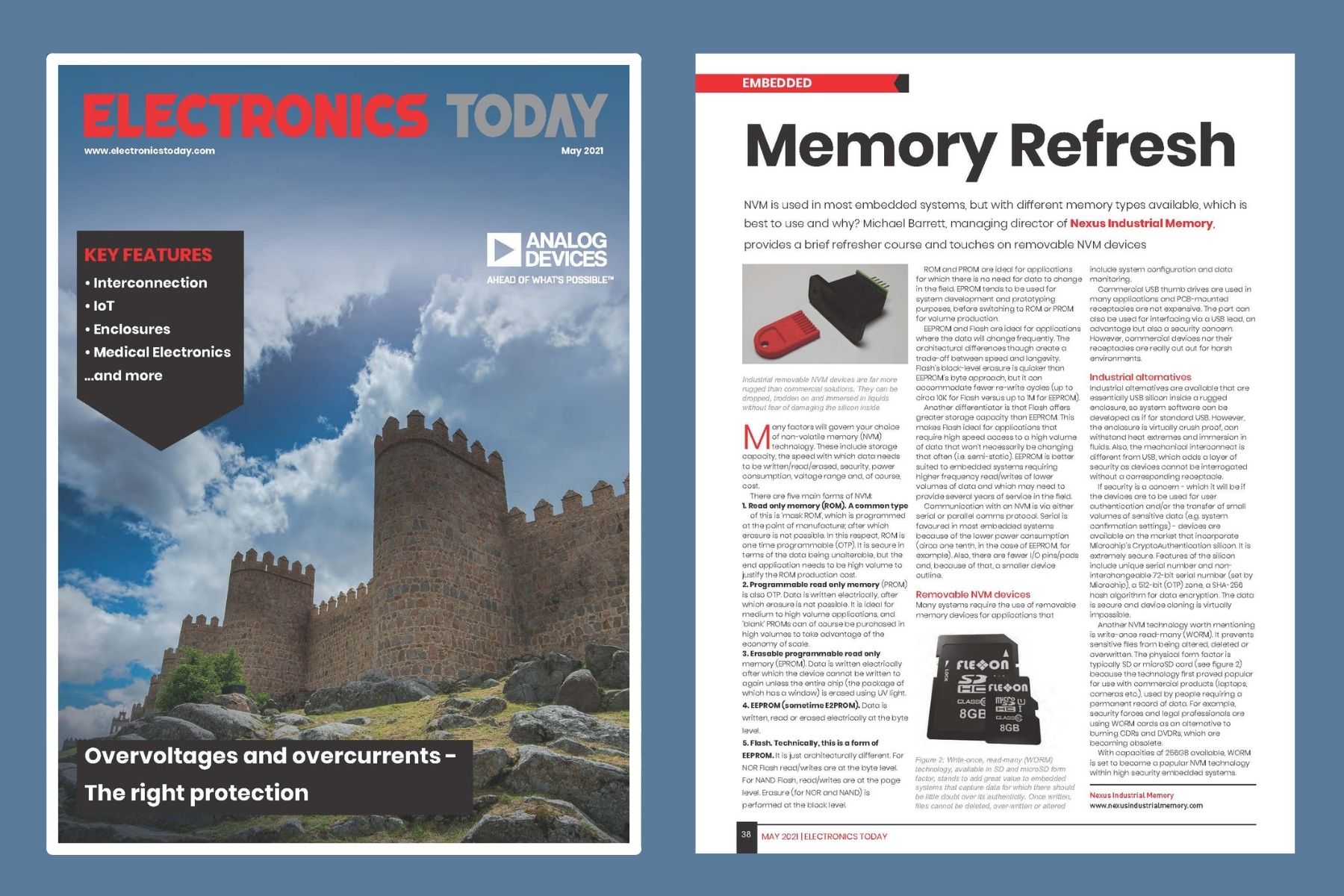View this article as a pdf
NVM is used in most embedded systems, but with different memory types available which is best to use and why? Michael Barrett, Managing Director of Nexus Industrial Memory, provides a brief refresher course and touches on removable NVM devices.
Many factors will govern your choice of non-volatile memory (NVM) technology. These include storage capacity, the speed with which data needs to be written/read/erased, security, power consumption, voltage range and, of course, cost.
There are five main forms of NVM:
- Read only memory (ROM). A common type of this is ‘mask ROM’, which is programmed at the point of manufacture; after which erasure is not possible. In this respect, ROM is one time programmable (OTP). It is secure in terms of the data being unalterable, but the end application needs to be high volume to justify the ROM production cost.
- Programmable read only memory (PROM) is also OTP. Data is written electrically, after which erasure is not possible. It is ideal for medium to high volume applications, and ‘blank’ PROMs can of course be purchased in high volumes to take advantage of the economy of scale.
- Erasable programmable read only memory (EPROM). Data is written electrically after which the device cannot be written to again unless the entire chip (the package of which has a window) is erased using UV light.
- EEPROM (sometime E²PROM). Data is written, read or erased electrically at the byte level.
- Technically, this is a form of EEPROM. It is just architecturally different. For NOR Flash read/writes are at the byte level. For NAND Flash, read/writes are at the page level. Erasure (for NOR and NAND) is performed at the block level.
ROM and PROM are ideal for applications for which there is no need for data to change in the field. EPROM tends to be used for system development and prototyping purposes, before switching to ROM or PROM for volume production.
EEPROM and Flash are ideal for applications where the data will change frequently. The architectural differences though create a trade-off between speed and longevity. Flash’s block-level erasure is quicker than EEPROM’s byte approach, but it can accommodate fewer re-write cycles (up to circa 10K for Flash versus up to 1M for EEPROM).
Another differentiator is that Flash offers greater storage capacity than EEPROM. This makes Flash ideal for applications that require high speed access to a high volume of data that won’t necessarily be changing that often (i.e. semi-static). EEPROM is better suited to embedded systems requiring higher frequency read/writes of lower volumes of data and which may need to provide several years of service in the field.
Communication with an NVM is via either serial or parallel comms protocol. Serial is favoured in most embedded systems because of the lower power consumption (circa one tenth, in the case of EEPROM, for example). Also, there are fewer I/O pins/pads and, because of that, a smaller device outline.
Removable NVM Devices
Another consideration is just how embedded does your embedded memory need to be? Many systems require the use removable memory devices for applications that include system configuration and data monitoring.
Commercial USB thumb drives are used in many applications and PCB-mounted receptacles are not expensive. The port can also be used for interfacing via a USB lead, an advantage but also a security concern. However, commercial devices nor their receptacles are really cut out for harsh environments.
Industrial alternatives are available that are essentially USB silicon inside a rugged enclosure, so system software can be developed as if for standard USB. However, the enclosure is virtually crush proof, can withstand heat extremes and immersion in fluids. Also, the mechanical interconnect is different from USB, which adds a layer of security as devices cannot be interrogated without a corresponding receptacle.
If security is a concern – which it will be if the devices are to be used for user authentication and/or the transfer of small volumes of sensitive data (e.g. system confirmation settings) – devices are available on the market that incorporate Microchip’s CryptoAuthentication silicon. It is extremely secure. Features of the silicon include unique serial number and non-interchangeable 72-bit serial number (set by Microchip), a 512-bit (OTP) zone, a SHA-256 hash algorithm for data encryption. The data is secure and device cloning is virtually impossible.
Another NVM technology worth mentioning is write-once read-many (WORM). It prevents sensitive files from being altered, deleted or overwritten. The physical form factor is typically SD or microSD card (see figure 2) because the technology first proved popular for use with commercial products (laptops, cameras etc), used by people requiring a permanent record of data. For example, security forces and legal professionals are using WORM cards as an alternative to burning CDRs and DVDRs, which are becoming obsolete.
With capacities of 256GB available, WORM is set to become a popular NVM technology within high security embedded systems.
This article was written in close collaboration with Nexus Industrial Memory and appeared in the May 2021 issue of Electronics Today magazine. It appeared in print, is online here and is reproduced on our site with the editor’s kind permission.

